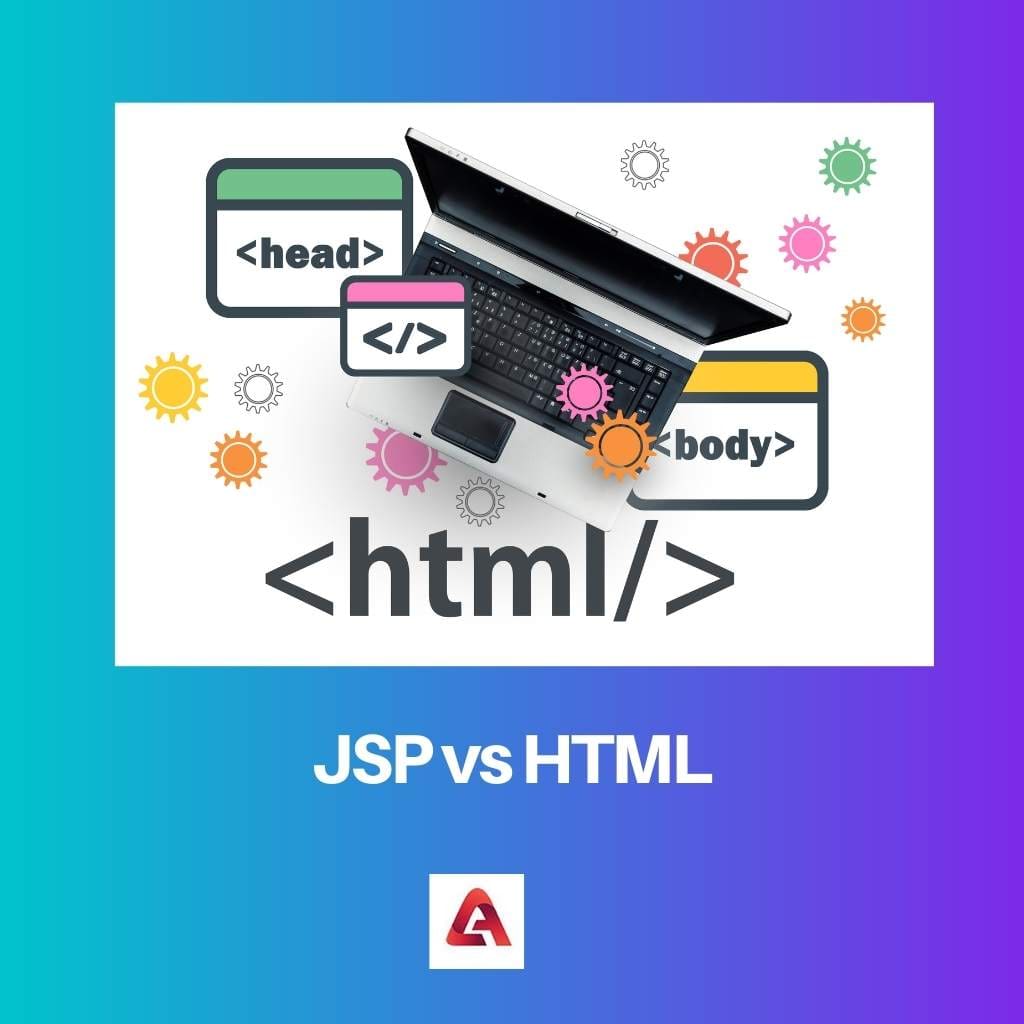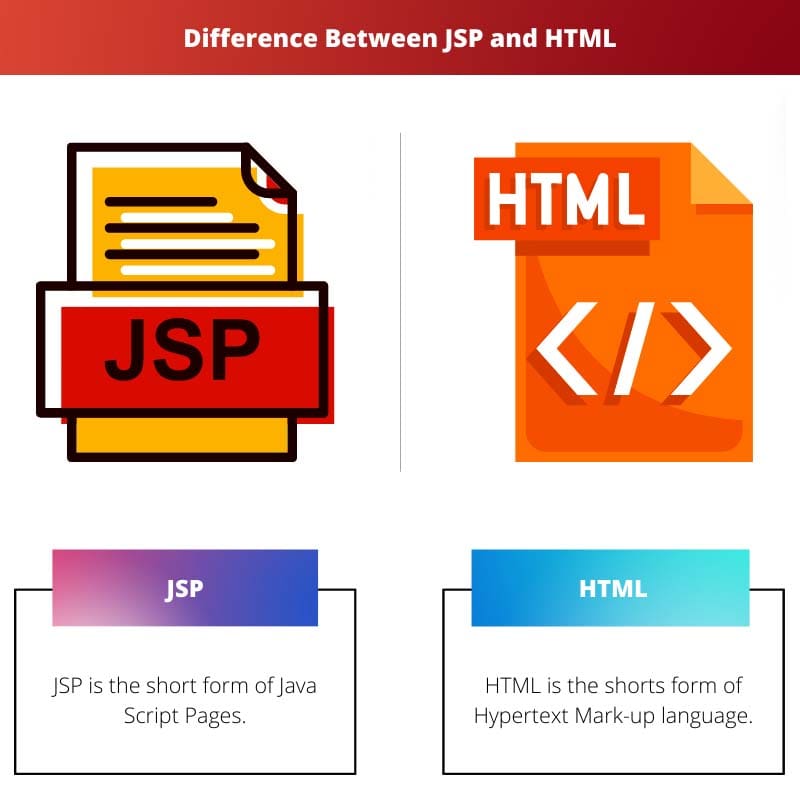A person who is well versed in the idea of coding and has taken a degree in it will surely know different coding standards. These are used to build up programs and software.
From filling out a form online to taking online admissions, coding plays a very important role in formatting the form’s structure. Two such coding software are HTML and JSP.
Key Takeaways
- HTML is a markup language used for creating static web pages that can be displayed in a web browser.
- JSP (Java Server Pages) is a technology used for creating dynamic web pages that can be generated on the server side before being sent to the client-side browser.
- While HTML creates static content, JSP creates dynamic content that can interact with databases and other server-side technologies.
JSP vs HTML
The difference between JSP and HTML is that JSP is an interface, which helps in invoking the change inactions of a server by changing data continuously through a dynamic interface, and on the other hand, HTML is a program that helps in giving information of structured accounts in the form of text-based information in a document.

JSP is the short form of javascript pages. These types of files are an extension of the older version of JSP. A major advantage of JSP is that it can be modified and coded inside the HTML coding.
For inserting a javascript, there is the availability of Java tags. A programmer writes the JSP coding at the end of the Java coding.
HTML is the short form of Hypertext Mark-up language. This is a classic coding used to design documents that are displayed online and viewed by people for filling out online forms.
It is the standard language used for formatting the structure of any web page. The HTML consists of language marked upon, and because of this, there are several tags available in HTML.
Comparison Table
| Parameters of Comparison | JSP | HTML |
|---|---|---|
| Full form | The full form of JSP is Java Script Pages. | The full form of HTML is HyperText Markup Language. |
| Run on | This directly runs on the webserver. | This directly runs on the web browser. |
| Cryptic Language | Actions performed in it are from the server-side. | Actions Performed in this are from the client-side. |
| Type of web page | This runs only on a dynamic page. | This runs only on a static page. |
| Loading process | The loading process is very slow. | The loading process is very fast. |
What is JSP?
JSP is the short form of (Java Script Pages). These types of files are an extension of the older version of JSP. A major advantage of JSP is that it can be modified and coded inside the HTML coding.
For inserting a javascript, there is the availability of Java tags. A programmer writes the JSP coding at the end of the Java coding.
A programmer must complete various tasks; for this, he uses the several tags available in a JSP. These tags help share the data pages between different requests made on the web page. These tags also help in getting control of the data from the database.
The JSP is initially written on top of a Java server named the Java servlet. This technology was developed and released by the company Sun Microsystems. This was released long back in 1999.
This technology was introduced with the main aim of creating sites in the most dynamic way possible. A page will continuously update and improvise once its nature is dynamic.

What is HTML?
HTML is the short form of (Hypertext Mark-up language). This is a classic coding used to design documents that are displayed online and viewed by people for filling out online forms.
It is the standard language used for formatting the structure of any web page. The HTML consists of language marked upon, and because of this, there are several tags available in HTML.
These texts are used information from texts, tables, cells, options, multiple choices with ticks and crosses, etc. The head and the body are two main parts of an HTML coding process to form a site or a form.
In the head section of an HTML, it defines the name of the database coding, and on the Other hand, the body sections contain all the tables and texts.
Over the years, HTML versions have been upgraded; the latest version is HTML 5. It has all the possibilities of advanced structure, such as the input of videos, etc. HTML uses a language that is simple to be used for forming a page.

Main Differences Between JSP and HTML
- JSP (Java Script Pages) was invented and released by the company sun microsystems, and on the other hand, HTML (Hypertext Mark-up Language) was invented long back in the world 1990s by Tim Berners Lee.
- The JSP (Java Script Pages) is useful for generating only a dynamic web page, and on the other hand, the HTML (Hypertext Mark-up Language) is useful for generating only a static web page.
- The JSP (Java Script Pages) is run directly on the web server, and on the other hand, the HTML (Hypertext Mark-up Language) is run directly on the web browser.
- There is cryptic language from the server’s side in JSP (Java Script Pages); on the other hand, cryptic language from the client side in HTML (Hypertext Mark-up language).
- The JSP (Java Script Pages) loads real slow due to its connection with the web server, and on the other hand, the HTML (Hypertext Mark-up Language) loads really fast due to its private server created for a web browser.

- http://grch.com.ar/docs/pp/Tutorial/e.commerce.app.ref/Servlets.and.jsp.pages.best.practices.rtf
- https://books.google.com/books?hl=en&lr=&id=ZFplJ5Sjo2oC&oi=fnd&pg=PA5&dq=jsp+vs+html&ots=1wO2rYQHH2&sig=0pH6MHBunx3cbX7DjI3lTTYo5Pc

I’m not sure I completely agree with all the points made in the article. Some areas seem debatable.
Certainly, Klee. An open dialogue can lead to further insights.
It’s always good to have differing perspectives to encourage discussion.
The details on the Java server and HTML in the article were intriguing.
Indeed, Klee. It’s a fascinating topic to explore.
The article provides a good foundation for understanding these technologies.
I appreciate the detailed comparison between JSP and HTML. It really helped me understand their unique features.
Yes, the comparison was very informative. Great read!
The historical background of JSP technology was well depicted in the article. It added more context to its development.
The historical aspects indeed provide a deeper understanding.
While the article presents valuable information, the loading speed comparison seems inaccurate based on my experience.
Loading speeds may also depend on different circumstances. This could be a topic for debate.
It’s interesting to hear differing opinions on the loading speeds. It’s worth further discussion.
The article provided a clear overview of JSP and HTML. I feel more informed now.
That’s great to hear, Mandy Brown! Knowledge is power.
HTML has evolved significantly over the years, and the article captured the advancements well.
Agreed, the advancements in HTML are very interesting.
This is an amazing article! I learned so much about coding standards and the differences between HTML and JSP.
It’s always great to learn new information, thank you for sharing your thoughts.
Glad to see you enjoyed the article, Lisa57!
The comparison table for JSP and HTML made it easy to understand the differences. Great addition to the article.
I agree, the comparison table was a standout feature.
The article offered a well-structured comparison between JSP and HTML. A compelling read!
Yes, the article made the comparison very clear and concise.
I found the structure of the article very engaging as well.